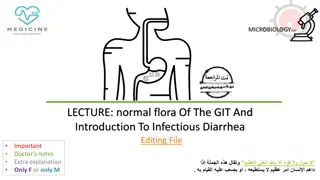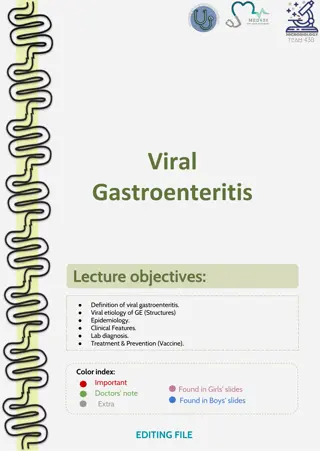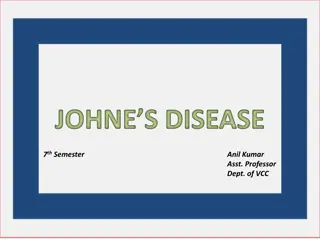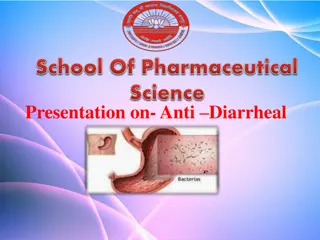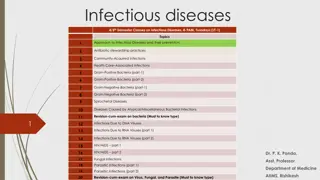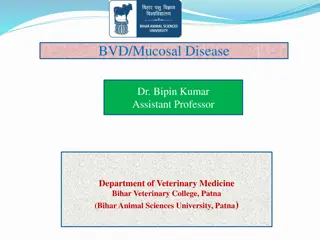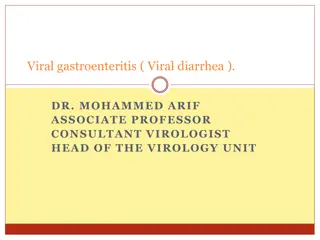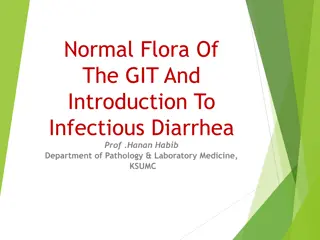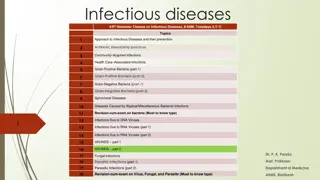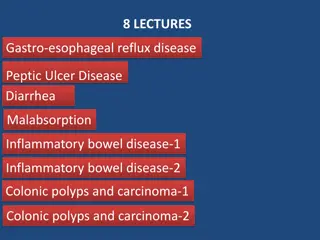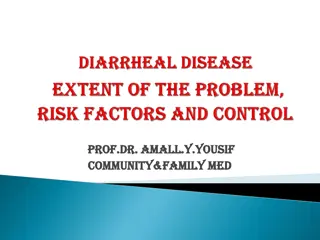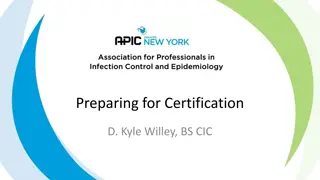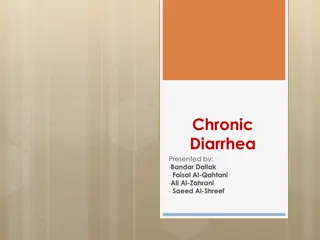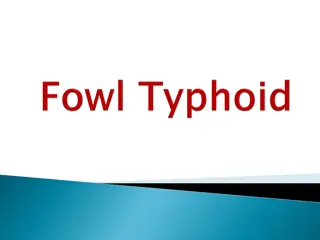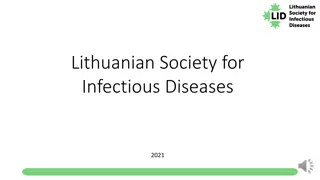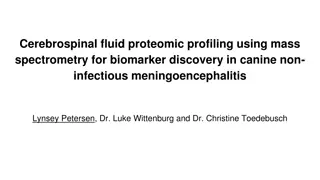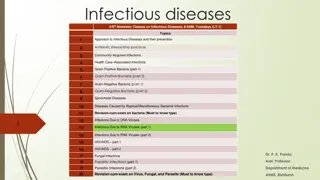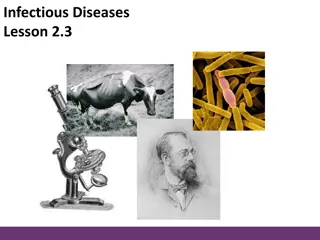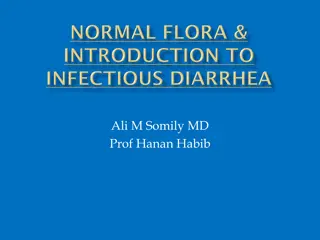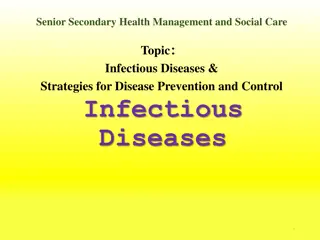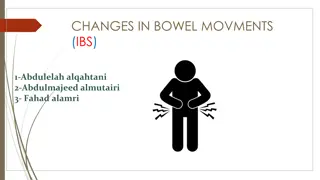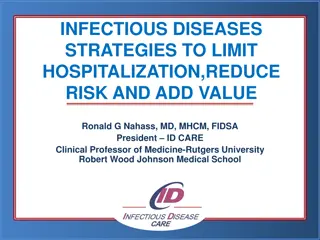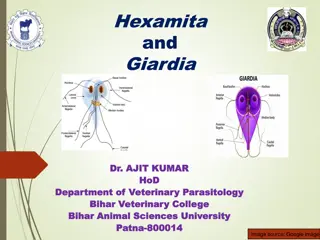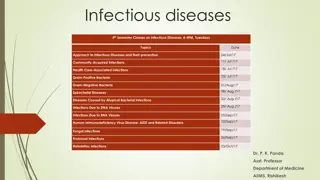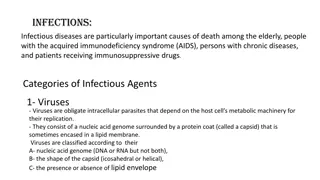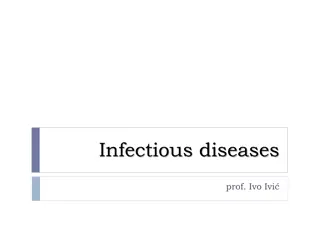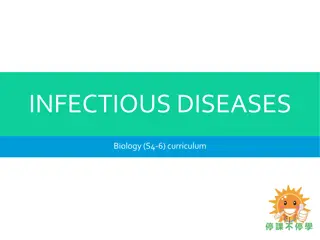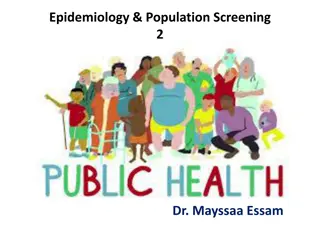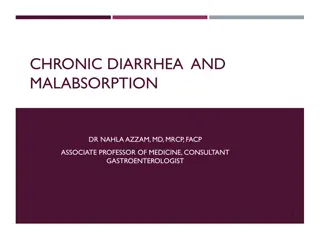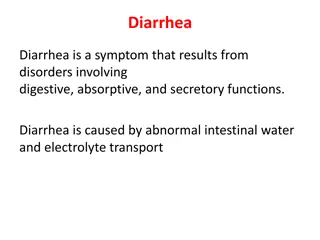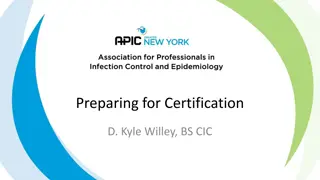Innovations in Infectious Disease Control: Insights from Experts
Explore the latest advancements in infectious disease control through the lens of renowned epidemiologists and researchers. Delve into the impact of the COVID-19 pandemic, the historical prevalence of infectious diseases, and early infection prevention practices. Uncover the evolution of infectious
0 views • 22 slides
Normal Flora of the Gastrointestinal Tract & Infectious Diarrhea
Normal flora in the gastrointestinal tract play a crucial role in maintaining health, but can also cause disease in certain conditions. This lecture covers the common flora in the GIT, their role in diseases, various types of acute diarrheal illnesses, epidemiology, and management of bacterial agent
1 views • 26 slides
Mystery Case Study: 75-Year-Old Male with Fever and Altered Mental Status
A 75-year-old male with a history of multiple animal exposures presented with fever, altered mental status, headache, and diarrhea. Physical exam revealed vital signs within normal limits, and labs showed various results including negative infectious disease workup but pending further tests. Imaging
0 views • 11 slides
Overview of Viral Gastroenteritis: Etiology, Epidemiology, Clinical Features, Diagnosis, and Treatment
Viral gastroenteritis is an inflammation of the gastrointestinal tract primarily affecting the stomach and small intestine, leading to symptoms like acute diarrhea and vomiting. It can be caused by various infectious agents such as Rotavirus, Adenovirus, Caliciviruses, Astrovirus, Coronavirus, Torov
1 views • 7 slides
Johne's Disease in Ruminants: Causes, Transmission, and Clinical Findings
Johne's Disease, caused by Mycobacterium paratuberculosis, is a chronic bacterial infection affecting the lower intestinal tract of ruminants. It is characterized by chronic diarrhea and emaciation, mainly seen in mature animals. The mode of transmission includes contaminated food/water, intrauterin
0 views • 12 slides
Anti-Diarrheal Agents and Their Mechanisms
Diarrhea is a common gastrointestinal issue characterized by increased bowel movements and abdominal discomfort. This presentation delves into the causes and types of diarrhea, including acute and chronic forms. It also explores the various classes of anti-diarrheal medications and their mechanisms
1 views • 23 slides
Comprehensive Overview of Infectious Diseases: Classes and Historical Perspectives
Infectious diseases are a significant public health concern, with various classes and prevention strategies discussed in a structured educational setting. The course covers topics ranging from antibiotic stewardship to viral infections, providing insights into the historical perspective of infectiou
0 views • 32 slides
Bovine Virus Diarrhea and Mucosal Disease in Cattle
Bovine Virus Diarrhea (BVD) and Mucosal Disease (MD) are two clinically distinct yet interconnected syndromes in cattle caused by Pestivirus. While originally thought to be separate, they share a common viral etiology. BVD can lead to persistent infections, while MD is sporadic, progressive, and fat
0 views • 14 slides
Viral Gastroenteritis: Causes, Symptoms, and Transmission
Viral gastroenteritis, commonly known as viral diarrhea, is a prevalent infection affecting mainly infants and young children. The disease is self-limiting, with symptoms like diarrhea, vomiting, and abdominal pain. Key viral etiologies include Rota viruses, Astroviruses, Norovirus, and Enteric aden
0 views • 19 slides
The Normal Flora of the Gastrointestinal Tract and Infectious Diarrhea
Explore the common normal flora of the gastrointestinal tract (GIT) and how they play a role in health and disease, specifically focusing on infectious diarrhea. Learn about different types of acute diarrheal illnesses, epidemiology, host defenses against GI infections, and the pathogenesis of bacte
0 views • 38 slides
Approach to Infectious Diseases: Antibiotic Stewardship, Bacterial Infections, and HIV/AIDS Clinical Staging
In the 4th-5th semester classes on infectious diseases, topics such as antibiotic stewardship, community-acquired infections, and various bacterial diseases are covered. The clinical manifestations and WHO clinical staging of HIV/AIDS for adults and adolescents are also discussed in detail. The cour
0 views • 29 slides
Diarrhea: Causes, Classification, and Significance
This informative content delves into the physiology of fluid in the small intestine, defines diarrhea, and outlines its various types and common causes. It emphasizes the importance of addressing diarrhea promptly to prevent dehydration and electrolyte imbalances, especially in children, as it remai
3 views • 52 slides
Feco-Oral Diseases and Diarrhea Transmission
Feco-oral diseases, primarily transmitted through the fecal-oral route, remain a significant global health concern, especially affecting children under 5 and the elderly. Diarrhea, characterized by WHO as three or more watery stools in 24 hours, poses a substantial burden, with infectious agents cau
0 views • 46 slides
Comprehensive Guide to Certification in Infectious Disease Management
Dive into the world of infectious disease management certification with this comprehensive guide covering exam topics such as identifying infectious disease processes, surveillance, prevention/control strategies, employee health, and management/communication skills. Prepare yourself to excel in your
0 views • 19 slides
Chronic Diarrhea: Causes and Consequences
Chronic diarrhea is characterized by persistent loose, watery stools lasting more than 14 days. The condition can be caused by various factors such as osmotic, secretory, inflammatory, or motility disorders. In developing countries, it often follows acute infections, while in developed countries, un
0 views • 71 slides
Diarrhea: Causes, Symptoms, and Pathophysiology
Diarrhea is a common symptom that can be caused by various factors such as viral, bacterial, parasitic infections, dietary changes, drugs, systemic diseases, and intestinal obstructions. It can lead to dehydration and other serious complications if not treated promptly. The pathophysiology of diarrh
0 views • 15 slides
Foot-and-Mouth Disease (FMD) and Bovine Viral Diarrhea (BVD)
Foot-and-mouth disease (FMD) is a highly contagious animal disease affecting cloven-hoofed animals, while Bovine Viral Diarrhea (BVD) is a serious cattle disease caused by the BVD virus. FMD is not transmissible to humans and is caused by different strains of Aphthovirus. Symptoms of FMD include ves
0 views • 12 slides
Fowl Typhoid in Domestic Birds
Fowl Typhoid is a septicemic disease affecting domestic birds, characterized by acute and chronic phases, enlarged spleen, bronzy colored liver, and diarrhea. It is caused by Salmonella gallinarum and primarily affects young and adult chickens. The disease has a short incubation period of 4-5 days,
0 views • 7 slides
Overview of Bovine Viral Diarrhea Virus (BVDV)
Bovine Viral Diarrhea Virus (BVDV) is an RNA virus belonging to the Pestivirus genus in the Flaviviridae family. It is classified into BVDV-1 and BVDV-2 genotypes with distinct biotypes. BVDV is a significant infectious disease in the livestock industry worldwide, with high prevalence and clinical c
0 views • 14 slides
Lithuanian Society for Infectious Diseases: Advancing Infectious Diseases Diagnostics, Treatment, and Prevention
Lithuanian Society for Infectious Diseases is a non-profit organization in Lithuania that brings together healthcare professionals to improve the diagnosis, treatment, and prevention of infectious diseases. They participate in various initiatives, events, and collaborations, organize conferences, an
0 views • 7 slides
Canine CSF Proteomic Profiling for Non-Infectious Meningoencephalitis Biomarker Discovery
This study focuses on using mass spectrometry to analyze cerebrospinal fluid (CSF) proteomics in dogs with non-infectious meningoencephalitis, aiming to identify unique peptide signatures for improved diagnosis and monitoring. The research addresses the diagnostic and therapeutic limitations of this
0 views • 16 slides
Infectious Diseases: Approach, Prevention, and Viral Agents
Infectious diseases play a significant role in public health, with a focus on antibiotic stewardship, community-acquired and healthcare-associated infections, as well as various bacterial, viral, fungal, and parasitic agents. Specific topics include the prevention of infectious diseases, with a deta
0 views • 18 slides
Spread of Infectious Diseases
Explore the dynamics of disease spread, vaccination effects, and simulation activities in a lesson on infectious diseases. Dive into data analysis and Koch's postulates to understand the role of infectious agents in disease causation.
0 views • 10 slides
Infectious Disease Control in the Russian Federation
Infection control in the Russian Federation is managed by various agencies and organizations, with a focus on surveillance, prevention, and outbreak response. The country registered millions of cases of infectious diseases, with upper respiratory tract infections being prevalent. The anti-plague ser
0 views • 16 slides
Study on Using MLIL Model to Replace RIL for Studying Bacterial Diarrhea
Shigellosis, a diarrheal disease prevalent in developing countries, lacks an effective vaccine. This study aims to assess the protective capability of S. dysenteriae sub-unit pili proteins using the MLIL method. Mice were immunized with different protein variants, and the results indicate potential
0 views • 16 slides
Acute Diarrheal Illness and Gastrointestinal Infections
Acute diarrheal illness is a common issue globally, leading to significant morbidity and mortality. This lecture covers the types of acute diarrhea, host defenses, pathogens like E. coli, Campylobacter, and Yersinia, and their management. It also discusses microbiological diagnosis methods, food poi
2 views • 30 slides
Infectious Diseases and Prevention Strategies
Infectious diseases are caused by pathogens like bacteria, viruses, parasites, or fungi invading the body. These diseases can spread from person to person and sometimes from animals to humans. Common characteristics include potential severe outcomes, transmission modes, and the role of pathogens. Th
0 views • 27 slides
Irritable Bowel Syndrome: Symptoms, Diagnosis, and Management
Define constipation and diarrhea, discuss the definition, etiology, and classification of IBS, explain how to diagnose IBS, list alarm symptoms and differential diagnosis, provide a management plan and follow-up, and recognize when to refer to a specialist. People with irritable bowel syndrome may s
0 views • 35 slides
Strategies to Reduce Hospitalization and Improve Infectious Disease Management
Explore the importance of limiting hospitalization for infectious diseases, reducing risks, and adding value to patient care through the experiences shared by Dr. Ronald G. Nahass. The case study highlights the impact of inappropriate diagnosis and delayed consultations with infectious disease speci
0 views • 31 slides
Giardia: Morphology, Life Cycle, and Pathogenesis
Giardia is a protozoan parasite that causes chronic diarrhea in various hosts, including humans and animals. This parasite has unique morphology with trophozoite and cyst stages. Its life cycle involves direct reproduction through binary fission and transmission through contaminated food or water. G
0 views • 19 slides
Infectious diseases
Infectious diseases have been a significant health concern throughout history. This information outlines a class schedule focusing on various infectious diseases, their prevention, historical perspectives, definitions, terms, and transmission methods. The content covers different infectious agents,
0 views • 32 slides
Infectious Agents and Their Impact
Infectious diseases are significant causes of mortality in vulnerable populations due to infections caused by viruses and bacteria. Viruses are intracellular parasites with diverse genomic and capsid structures, leading to transient or chronic illnesses. Bacteria exhibit varied cell wall structures
0 views • 17 slides
Infectious diseases
Infectious diseases are caused by pathogenic microorganisms invading the host's body. This process involves the development of the disease through colonization, invasion, and immune responses. Pathogenic microorganisms exhibit virulence by directly damaging the host or inducing inflammatory response
0 views • 40 slides
INFECTIOUS DISEASES
Infectious diseases are caused by pathogens and can be transmitted through various ways such as droplets, air, water, and vectors. Learn about the key learning points related to infectious diseases and how to prevent them, including COVID-19. Understand the importance of hand hygiene, wearing masks,
0 views • 10 slides
Infectious diseases
Antibiotic stewardship practices, community-acquired infections, healthcare-associated infections, gram-positive and gram-negative bacteria, spirochetal diseases, viral infections, fungal and parasitic infections, surveillance and prevention of infectious diseases, common pathogens in UTI, and antib
0 views • 21 slides
Chronic Diarrhea and Malabsorption
Chronic diarrhea, lasting more than four weeks, can occur in up to 5% of the population. It is a symptom that may indicate various conditions affecting the gut's fluid secretion and motility. The gut absorbs fluid but may expel unwanted material in response to infections or toxins, leading to diarrh
0 views • 49 slides
Epidemiology & Population Screening
Infectious diseases are characterized by living infectious agents transmissible through hosts and the environment. Understanding the components of communicable diseases, infectious agents, reservoirs of infection, and the influence of biological properties is essential in controlling disease spread.
0 views • 31 slides
Chronic Diarrhea and Malabsorption Overview
In this informative material, Dr. Nahla Azzam, MD, MRCP, FACP, delves into the definitions, classifications, mechanisms, and systematic approach to chronic diarrhea and malabsorption. Through case studies and explanations, the content sheds light on clinical manifestations, causes, and next steps in
110 views • 48 slides
Diarrhea
Diarrhea is a common symptom resulting from digestive issues and abnormal water-electrolyte transport. It can be classified based on duration, severity, and causes such as infections or malabsorption. Acute diarrhea lasts less than two weeks, while chronic diarrhea persists for more than two weeks.
71 views • 19 slides
Preparing for Certification
This content provides a detailed breakdown of the topics covered in a certification exam for infectious disease control. It includes sections on identification of infectious disease processes, surveillance and epidemiologic investigation, preventing and controlling transmission of infectious agents,
0 views • 20 slides

